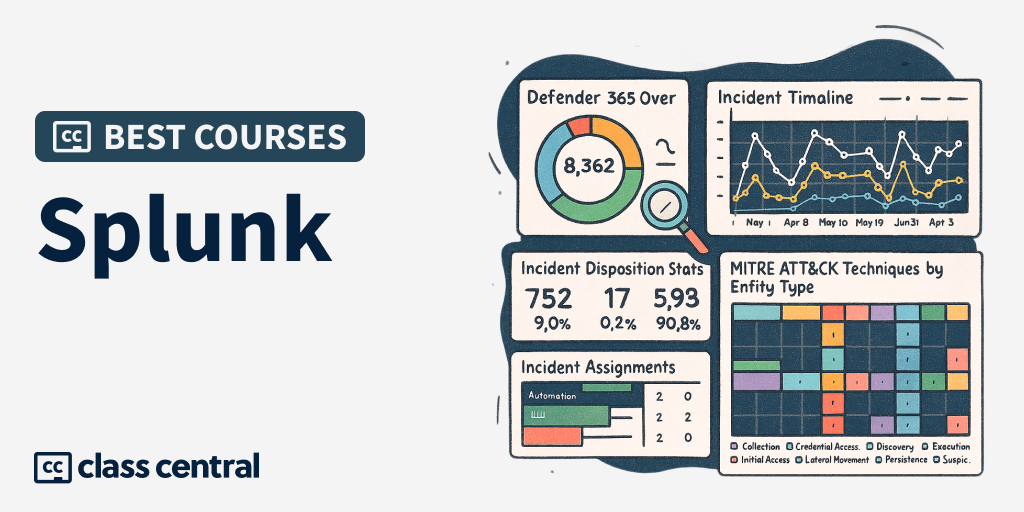

Splunk is the first Security Information Event Management (SIEM) solution that I encountered in my cybersecurity journey; due to its huge popularity, there are a plethora of videos and courses available. This makes it easily accessible to beginners who want to have hands-on SIEM.
The term SIEM was coined in 2005 by Mark Nicolett and Amrit Williams by combining capabilities of two previous-generation solutions, i.e., Security Information Management (SIM) and Security Event Management (SEM).
We can think of SIEM as an advanced radar system, which is hard coded to monitor all the aerial (cyber) activity and signals (alerts) at the slightest unusual patterns. These signals are then interpreted in the Control (SOC) room to stop any possible airstrike (cyberattack).
Today, it’s impossible to imagine a SOC without a SIEM solution. It enables threat detection and security incident response through real-time collection and historical analysis of security events from a wide variety of events and contextual data sources. The SIEM platform collects log and event data from security systems, networks, and computers and turns it into actionable security insight.
- What is Splunk?
- Role of Splunk in Cybersecurity
- Why Should You Trust Us and This Guide?
- Best Splunk Courses
| Course Name | Workload |
| SOC Analyst Training-SIEM (Udemy) | 87 hours |
| Learn Fundamentals of Splunk (LinkedIn) | 2 hours |
| Introduction to SIEM (Coursera) | 7 hours |
| The Complete Splunk Enterprise Certified Admin Course (Udemy) | 4 hours |
| Splunk: Zero to Power User (Udemy) | 5 hours |
| Getting to Know Splunk: The Hands-On Administration Guide (Udemy) | 4 hours |
What is Splunk?
Splunk is a powerful data analytics platform that enables users to collect, index, search, analyze, and visualize large amounts of machine-generated data. The data can be gathered from websites, applications, sensors, devices, etc. Due to its ability to collect data from multiple sources, it can detect threats that individual security solutions can’t see.
Role of Splunk in Cybersecurity
- Real-time monitoring-
It monitors threats and correlates events in real time to find and stop cyberattacks. - Incident response-
In the event of a breach, it helps contain damage and reduce recovery time and cost. - User monitoring-
It monitors user activity, as privilege escalation and compromising accounts are standard MOs of attackers. - Threat Intelligence-
It allows advanced detection by enriching logs with threat intel. - Use Cases-
It offers a library of correlation rules to detect all kinds of attacks.
Why Should You Trust Us and This Guide?
Class Central is a TripAdvisor for online education. We make it easier to discover the right courses without having to jump across multiple platforms. With over 250,000 courses in our catalog, we’ve already helped more than 100 million learners find their next course.
Now, why should you trust this guide?
In my capacity as a senior security analyst, I have extensively worked on multiple SIEM solutions. I have created this course guide keeping in mind in-demand industry skills like building use cases, onboarding devices, parsing logs, writing advanced search queries using SPL, and creating reports and dashboards. Also, it’s not enough to just know how to use SIEM but also to understand its architecture and framework.
SOC Analyst Training – SIEM (Udemy)
- Level: Beginner to Intermediate
- Rating: 4.4
- Duration: 87.5 hours
- Cost: Paid
What You’ll Learn
- Basics of networking fundamentals
- Understand and analyze various log sources
- Create and manage dashboards and alerts for monitoring and reporting
- Walk through SIEM use cases and incident handling stages
- Get introduced to threat hunting techniques.
I often see aspiring cybersecurity professionals rushing into SOC/pentesting courses. While ignoring networking fundamentals, which are crucial in cybersecurity, as they enable analysts to understand how data flows across systems. This course addresses the elephant in the room and helps you build a base in networking.
What I like about this course is it covers all the other aspects like SOC dashboards, alerts, and SIEM use cases, creating real-time visualizations and alerts for security events like failed logins, suspicious IP activity, and phishing attempts. This course helps participants understand the stages of incident handling, such as detection and triage.
Further, it explores threat hunting techniques and maps them to the MITRE ATT&CK framework, which gives us insight into identifying tactics, techniques, and procedures used by attackers.
NOTE: Make note of scenario-based questions for interviews.
Learn Fundamentals of Splunk (LinkedIn)
- Level: Beginner
- Rating: 4.7
- Duration:1 hour 47 min
- Cost: Paid (Affordable)
What You’ll Learn
- Learn to set up and ingest data in Splunk
- Using Search Processing Language (SPL) to run searches.
- Creating reports and dashboards
- Creating alerts and setting thresholds.
- Universal forwarder
This course is beginner-friendly; you learn to set up and ingest data into Splunk. What makes this course stand out is that it uses a simple Python-based log generator to simulate realistic access of security logs without needing a full production environment. I remember earlier getting this kind of exposure required months of internship.
Josh builds a container for mapping directories and monitoring logs while also showing how Splunk automatically detects log formats like access_combined and linux_secure. It’s a simple yet effective way to practice working with live log data. Simulating real-time SOC activities, checking index and forwarder health, correlating events across multiple logs, and investigating anomalies helps connect theory with practical skills.
Introduction to SIEM (Coursera)
- Level: Beginner
- Rating: 4.7
- Duration: 6 hours 55 min
- Cost: Paid
What You’ll Learn
- SIEM Fundamentals & log management
- Log collection with Splunk
- Log search and analysis with Splunk
- Compliance and Reporting through Splunk
- Splunk Installation and Architecture
- Configuring and managing Splunk Indexer
As a SOC analyst, you have to configure SIEM to perform tasks like alert triage, check compliance, create correlation rules, fine-tune, etc. This course equips you to handle Splunk like a pro, whether it is installation, collecting logs, or integrating third-party solutions using API keys.
The course instructor explains everything in a simple and lucid manner; she guides us through the Splunk Web Interface to create dashboards, visualizations, and reports.
The course contains three modules and offers certification based on graded assignments, which helps if you want to validate your learning.
The Complete Splunk Enterprise Certified Admin Course (Udemy)
- Level: Beginner to Intermediate
- Rating: 4.4
- Duration: 3 hours 57 min
- Cost: Paid
What you’ll learn
- Understand Splunk fundamentals, SIEM concepts, and SOC processes
- Manage Splunk licenses, configuration files, and indexes
- Perform user and authentication management
- Get data into Splunk through staging, forwarders, and distributed search
- Configure and manage monitor, network, scripted, and agentless inputs
- Apply fine-tuning techniques, parsing, and raw data manipulation
This course gives a holistic picture of Splunk as a SIEM. You cover the basics of Splunk administration, including license management, configuration files, and index creation. While understanding how Splunk stores and organizes data efficiently, which is crucial for real SOC monitoring. Then it further delves into user management and authentication, creating different roles and permissions, which showed me how access controls work in environments.
Once we learn data ingestion, we can handle multiple log sources like Windows event logs, Linux syslog, firewall logs, web proxy logs, and email gateway logs using different input types like monitor, network, scripted, and agentless inputs. Knowing how data flows into Splunk from various systems, and how parsing and field extraction are done, ensures accurate data interpretation for analysis.
Splunk: Zero to Power User (Udemy)
- Level: Beginner to intermediate
- Rating: 4.4
- Duration: 4 hours 50 min
- Cost: Paid
What You’ll Learn
- Setting up a Splunk instance on your system.
- Creating dashboards, reports, alerts, and searches
- Learn to write SPL queries
- Splunk Architecture-Forwarder, Indexer, and Search Head
- Types of Splunk Deployment
What I like the most is that this course uses a blend of lectures and demos, making it more engaging. This course is designed for you to pass the Splunk Core Certified Power User exam. The course instructor, Hailie Shaw, gives a hands-on demonstration on a Splunk instance as she writes queries using Search Processing Language (SPL) to showcase basic commands. This course also covers dashboard, report, and alert creation.
What separates this course from others is that it covers types of Splunk deployment, such as standalone, basic, and multiple instance deployment, which gives you insight into the Splunk architecture.
Getting to Know Splunk: The Hands-On Administration Guide (Udemy)
- Level: Intermediate
- Rating: 4.4
- Duration: 4 hours
- Cost: Paid
What You’ll Learn
- Splunk Fundamentals and Terminology
- Data onboarding into Splunk
- Data Normalization in Common Information Model (CIM)
- Advanced searching to visualize data.
- Creating dashboards and reports in Splunk
This course is ideal for beginners with no prior experience in Splunk. As it starts off by familiarizing you with the key terms in Splunk. Course instructor Tom then gives a walkthrough on building a Splunk environment, ingesting data, and adding normalized data to the Common Information Model (CIM). It’s a vendor-neutral tagging so that different logs behave in a similar manner.
You’ll learn to set up Splunk on Linux, set basic configs, and get logs flowing to simulate. So you’ll need some familiarity with the Linux command line. Also, this covers some advanced searching concepts using chart, timechart, geostats, and IP location.
Note: The only drawback is that the course was last updated in 2018, and you would miss out on some Splunk functionalities.
The post 6 Best Splunk Courses in 2025 Curated by a Senior Security Analyst appeared first on The Report by Class Central.









![[2025] Hundreds of Free Courses to Learn JavaScript, React, Node](https://365daily.net/wp-content/uploads/2025/10/js-and-frameworks-banner-5aJAeA-768x384.png)





